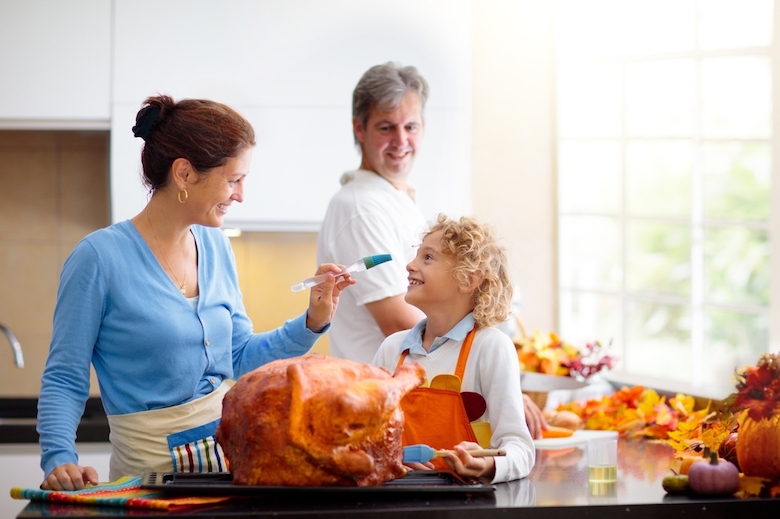Thanksgiving Cooking Safety Tips You’ll Be Grateful For

Most people’s memories of Thanksgiving revolve around food, and that likely means someone — maybe you — is spending a lot of time in the kitchen. But kitchen catastrophes can be far more serious than just dealing with lumpy gravy. According to the National Fire Prevention Association (NFPA), cooking is the top cause of house fires — and Thanksgiving was the peak day for these home cooking fires, its most recent research found.
Let’s talk turkey about ways to stay safe in the kitchen while you’re prepping your feast.
1. Keep your stove clean
You might expect candles or fireplaces to be responsible for most fires, but believe it or not, the No. 1 cause of house fires is actually cooking. A common culprit is a dirty stove that allows grease to catch on fire. So clean your stove, but also keep a lid nearby to slide over the pot or pan if one should flare. Another cause is clutter, such as wooden spoons or hanging kitchen towels that catch a spark, so keep all flammable items away from the burners. And never leave any pot or pan unattended on the stove.
2. Wear appropriate clothing
You might choose to wear an apron to avoid staining your good clothes, but suitable attire is not just about aesthetics. In particular, think carefully about what’s on top and avoid baggy or loose sleeves which can get caught in mixer beaters or on pot handles, or catch fire if you get too close to the flame on the stove.
Footwear matters too. Scalding liquid can burn feet if you’re wandering around the kitchen in open-toed shoes or bare feet; socks without grippers can make you slip and slide; and high heels can cause a fall. Choose sturdy, closed-toe flat shoes. And if you do spill, attend to it right away so the floor is always clean and dry to reduce the possibility of slipping.
3. Adhere to food safety guidelines.
Leftovers are part of the fun of Thanksgiving, but only if you handle them correctly. The main goal is to keep hot food hot and cold food cold.
FoodSafety.gov offers four simple guidelines that can help prevent serving up food poisoning.
- Clean: Wash hands, utensils, counters, and other surfaces often.
- Separate: Keep raw meat, poultry, seafood, and eggs separate from other ingredients and ready-to-eat foods to prevent the spread of bacteria.
- Cook: Use a food thermometer to confirm food is cooked to the appropriate temperature.
- Chill: Refrigerate leftovers promptly.
4. Cut with care
A sharp knife lets you dice those veggies and spices in no time, but it only takes a second to nick your finger, too. That’s why you should always chop food on a flat, stable surface. And keep your knives sharp — it sounds counterintuitive but you’re more likely to be injured by a dull knife because you need to apply more pressure, which makes it more likely to slip.
5. Don’t disable your smoke alarm
Some smoke alarms can seem overzealous and start blaring when something on your stove or in the oven is emitting steam. It can be tempting to temporarily silence it, but that can lead to danger. Instead open the windows and let some air in to prevent this.
While you’re thinking about your smoke alarm, now is a good time to change the batteries. The International Fire Chiefs Association has launched a campaign called “Change Your Clock. Change Your Battery” encouraging people to change their fire alarm batteries on the same day we switch to Daylight Saving Time, the first Sunday in November. If you missed it, why not do it now?
6. Have a working fire extinguisher ready and know how to use it.
While it’s good news if you haven’t had to use your fire extinguisher, they don’t last indefinitely, and manufacturers recommend you replace it after 10 years. This is also a good time to review effective fire extinguisher use. The National Fire Prevention Association suggests you remember the word PASS to remind you how to use it:
- Pull the pin. Hold the extinguisher with the nozzle pointing away from you, and release the locking mechanism.
- Aim low. Point the extinguisher at the base of the fire.
- Squeeze the lever slowly and evenly.
- Sweep the nozzle from side-to-side.
7. Don’t have too many cooks in the kitchen
Having too many people around — especially underfoot, like kids or pets — is not only annoying when you’re cooking, it can be dangerous for you and them. You could trip over them or spill something hot. Sometimes kids want to help, but make sure you are supervising them, rather than simultaneously attending to your own cooking. It might be best to save the cooking lessons for a day that’s less hectic.
No one wants to think about what might happen in case of a house fire, but it can be reassuring to know you’re covered with adequate insurance. If you’re a Matic policyholder, our team can help ensure you have the right coverage at an affordable price, and even help you save money by bundling with auto insurance. Reach out to [email protected] or call 888-380-6623 to review your coverage.



